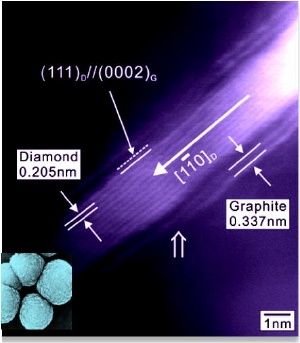May 14 2009
High aspect-ratio, nanoscale one dimensional (1D) diamond structures in the form of nanotubes, nanorods, nanowires, nanotips, nanopillars are of both theoretical and experimental significance and have been proposed as important components in future electronic, optoelectronic, flat panel displays, nanomechanical and biomedical nanodevices. However, the fabrication of thin one dimensional diamond nanostructures is currently a challenge and the investigation of their properties is at an infant stage.
 High magnification HAADF image of the tip of diamond nanorod. The inset is an SEM image illustrating the diamond nanorod integrated spherule structure.
High magnification HAADF image of the tip of diamond nanorod. The inset is an SEM image illustrating the diamond nanorod integrated spherule structure.
Engineers at the University of Ulster are the first researchers to create diamond nanorods with a diameter as thin as 2.1 nm, which is not only smaller than all the currently reported diamond 1D nanostructures (4-300 nm) but also smaller than the theoretical calculated value (2.7-9 nm) for energetically stable diamond nanorods. They actually established with the help of high resolution TEM studies carried both at Birmingham University and SuperSTEM facility in Daresbury Laboratory that the synthesis of ultrathin diamond nanorods (DNR) is possible, because they are encapsulated in a few graphene layers, which actually serve as a shield for keeping the DNR stable.
"This finding represents a milestone because it provides an insight on the growth of ultra-thin diamond nanorods and could actually act as a stimulus for future theoretical and experimental work" said Prof Papakonstantinou who is leader of the group at UU.
The ultrathin nanords were fabricated in a microwave plasma assisted chemical vapor deposition reactor using a mixture gas of nitrogen and methane gases. Together with some diamond nanocluster, graphene nanowires and carbon nanotubes, diamond nanorods were self-assembled into a spherical electron-emitting structure. This integrated self assembled nanostructure demonstrated excellent field electron emission performance, better than that of all other conventional (Mo and Si tips, etc.) and popular nanostructural ?eld emitters.
"This novel DNR-based integrated nanostructure has a potential for use as low-power cold cathodes as well as for medical technological applications" said Dr Naigui Shang a researcher at UU.
The results of the above work were published in the April edition of ACS Nano* , where the microwave CVD growth, microstructure and field emission of diamond nanorods have been studied by a combination of various spectroscopic techniques.
* Article: "Self-Assembled Growth, microstructure and Field-Emission High-Performance of Ultra-Thin Diamond Nanorods" By Nai Gui Shang, Pagona Papakonstantinou, Peng Wang, Alexei Zakharov, Umesh Palnitkar, I-Nan Lin, Ming Chu, Artemis Stamboulis, Acs Nano 2009, 3, 1032-1038